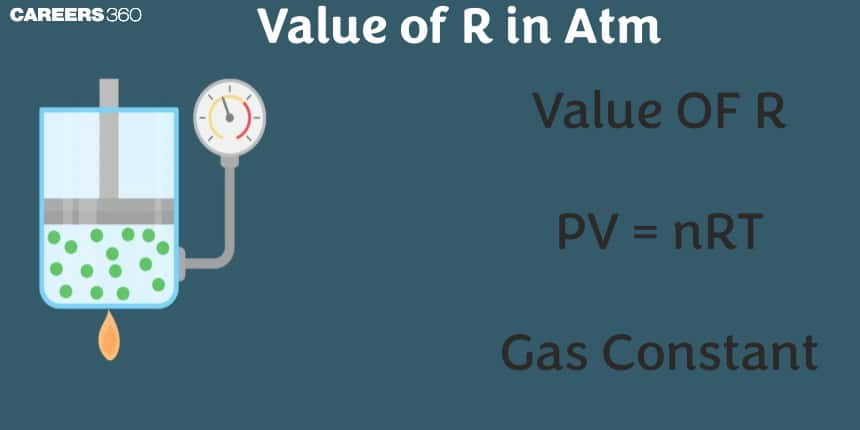Value of R in Atm - Value of Gas Constant, Formula, FAQs
The gas constant, also known as the ideal gas constant or the molar constant, is an important physical constant that is denoted by the letter "R" and is utilized in most of the fundamental equations of thermodynamics, kinetic theory of gases, and so on. The ideal gas constant R is defined in physics as -Work done by the gas (or on the gas) per unit mole per unit temperature change. Boyle's law, Charles' law, Avogadro's law, and Gay-law Lussac's are all used to create the constant. The ideal gas law, the Arrhenius equation, and the Nernst equation all contain it as a physical constant.
This Story also Contains
- What is the meaning of R
- Gas Constant Formula
- Gas Constant Value
- Universal Gas Constant Derivation
- Different Units Of R
- Summary

The gas constant is a constant proportionality in physics that links the energy scale to the temperature scale and the measurement of the quantities of the substance. As a result, prior decisions and accidents in the definition of energy, temperature, and material amount eventually decide the value of the gas constant. The Boltzmann constant and the Avogadro constant, which separately connect energy to temperature and particle count to substance amount, were also determined.
Also read -
What is the meaning of
The gas constant is defined in physics as the product of pressure and volume. R is an abbreviation for energy per temperature increase per mole. Value of R in atm is a constant. However, the value of the gas constant can be stated in a variety of units. R is also known as the ideal gas constant, the universal gas constant, and the molar constant.
As the pressure and volume of the system are changed, the value of R will change. Depending on the measuring system is being used, choose the appropriate R value.
The ideal condition is used to determine the R-value under various scenarios.
Also Read -Unit of Pressure
Gas Constant Formula
The gas constant
where,
Gas Constant Value
Universal gas constant R, which is a physical constant measured in units of energy per temperature increment per mole. The ideal gas constant, molar gas constant, and universal gas constant are all interchangeable names. The gas constant is identical to the Boltzmann constant; however, it is expressed as the pressure-volume product rather than energy per temperature increment per particle.
The value of R is
Universal Gas Constant Derivation
The combination of Boyle's law, Charle's law and Avogadro's law gives the ideal gas equation.It is a relation between four variables and describes any state of gas. It is also called the equation of state.
Boyle's law,
Charle's law,
Avogadro's law,
Combining these laws,
We can deduce from the ideal gas statement
Where,
The universal gas constant
We get by rearranging the previous equation for R:
This is the formula for the gas constant.
The unit of R is given by, which is derived from equation (2).
(Newton-meter = Joule)
As a result, the gas constant R is measured in
- The following formula is used to find the value of R at standard temperature and pressure).
Temperature is 273K, pressure is1.01105N/m2, and volume is 22.410-3m3 at STP for 1 mole of gas (n=1mol).
We find the gas constant value R by substituting these numbers in equation (2) and simplifying.
As a result, the value is
Related Topic:
Different Units Of R
R value can be stated in a variety of unit systems depending on the necessity for calculation. We know, for instance, that 1 calorie = 4184 joules when you use the gas constant R-value in calories, and then the value of R is.
Similarly, the gas constant R values can be expressed in a variety of units, as shown in the table below.
| Value of R | Units of R |
| 8.31 | J mol⁻¹K⁻¹ |
| 1.98 | Cal mol⁻¹ K⁻¹ |
| 8.31 | m³(Pa)mol⁻¹K⁻¹ |
| 0.0821 | L(atm) mol⁻¹K⁻¹ |
| 62.36 | L(torr) mol⁻¹K⁻¹ |
| 1.98 x 10⁻³ | kCal mol⁻¹K⁻¹ |
| 8.3144598 × 103 | amu.m2.s-2.K-1 |
| 8.3144598 × 10-2 | L.bar.K-1.mol-1 |
Also, check-
Summary
The gas constant R is an essential parameter in thermodynamics and physical chemistry. It helps in facilitating the understanding and calculation of gas behaviours. In this article, we learnt about the definition of the gas constant, R-value and its different units. Its values vary based on units. The gas constant R is a crucial constant in thermodynamics and ideal gas equation.
Also Read:
Frequently Asked Questions (FAQs)
The value of R is
The S.I unit of gas constant is J mol⁻¹K⁻¹.
We know from the ideal gas equation that,
R=PV/nT
P=1atm, T=273K, and V=22.4L for n=1mol at STP,
By substituting the above values into the R equation,
R = 1 atm x 22.4 L/1 mol x 243 K
The required answer isR = 0.0821 L(atm) Mol-1K-1.
The value of the gas constant 'R' is determined by the pressure, volume, and temperature units used.
R = 0.0821 litre.atm/mol-K,
R = 8.3145 J/mol-K,
R = 8.2057 m3atm/mol-K,
R = 62.3637 L-Torr/mol-K,
PV=nRT, where n is the number of moles and the universal gas constant R is the ideal gas law. The value of R varies depending on the units used, but it is commonly expressed as R = 8.314 J/mol-K in S.I. units. As a result, the gas constant R value is equated to 287 J/kg-K can be used for air.
The value of R is computed accordingly at atm i.e. at STP (standard temp and pressure). At STP, the temperature value is 273K, for 1 mole of gas (n=1 mol), the pressures are1.01105.
The dimensions are energy per degree per mole of the universal gas constant R. The value of R is 8.314598 joules of kelvin (K) a mole in the meter-kilogram-second system.